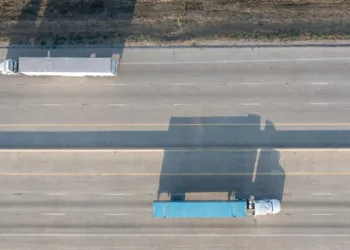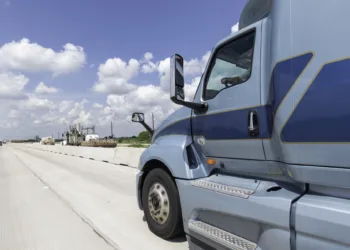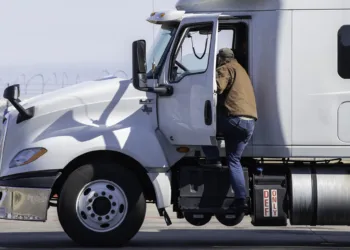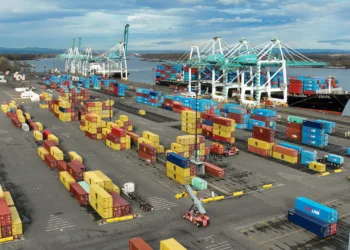
On a special episode of Truck Tech, host Alan Adler spoke with Derek Turbide, vice president of business development at Clean Energy, and Scott Edelbach, executive vice president at Opal Fuels, about the advantages of public and private fueling stations.
For potential buyers of natural gas-powered commercial vehicles, an important topic is understanding the ecosystem and infrastructure surrounding the fuel source.
Clean Energy Fuels’ multi decade push for public station expansion
Clean Energy Fuels, North America’s largest provider of renewable natural gas for the transportation market, focuses on upstream renewable natural gas fuel development from RNG digesters at dairy farms, landfills and wastewater treatment plants that harvest methane that would otherwise be released into the environment. The harvested gasses are cleaned and put into a pipeline for allocation to any of Clean Energy’s stations. Turbide notes that the company has been building out its network of natural gas stations for nearly 30 years.
The development of the X15N platform, which integrates a Cummins engine block with a natural gas header, is expanding opportunities for Clean Energy. Turbide believes that the longer range and capabilities of the 15-liter natural gas engine will allow for a faster rate of station expansion to meet the new demand. He predicts about a 10% increase in stations each year.
With the rise in natural gas fleet adoption by public and private fleets, there is an increase in the need for locations where RNG trucks can fuel. Clean Energy operates approximately 200 tractor-trailer-friendly stations across North America, strategically located along major trucking corridors. Turbide added, “We don’t have one on every corner but we’re growing that network, and it’s the old chicken and the egg. These are multimillion-dollar investments [that] we’re putting in these stations. We want to make sure that we’ve got customers to fuel at those stations, and it only takes around 20 or so trucks to get a new station going.”
On the net-zero front, the ability of RNG to produce a lower or even negative carbon intensity score is an added benefit for fleets looking to reduce overall emissions. For instance, on a dairy farm capturing methane emissions, the cleaned and processed natural gas can be used to offset the emissions generated by the farm’s operations.
RNG market penetration is also key, with nearly 100% of natural gas in California being renewable and around 80% of natural gas coming from renewable sources nationwide. The goal is to increase production to handle the added demand from the larger 15-liter engines on the market. “If we can surpass that billion-gallon mark as an industry and a half a billion-gallon mark as Clean Energy, we’re on the right road,” said Turbide.
He estimates there’s potential for nearly 40 billion gallons of RNG across the U.S., but it will take time to capture and process all of that natural gas.
For cost, fleets looking to adopt are seeing around $2 per diesel gallon equivalent. “That’s kind of that sweet spot where they can start to make the math really work for their own operation in total cost of ownership,” said Turbide. For larger fleets that own private stations and invest in offsetting carbon credits, that cost can be even lower.
Adler also spoke with Mirsad Dzebic, business development manager at Clean Energy, at a Clean Energy fueling station in Woodhaven, Michigan. The station itself is relatively new, under a year old and includes a public fast-fill site in the front, then behind a fence private time-pressure pumps. “With the public fast fill, we’re really able to drive volume to this location,” said Dzebic.
Key factors when building a dedicated behind-the-fence station
Edelbach, of Opal Fuels, spoke with Adler about what to consider when creating a private, behind-the-fence operation. Adler noted that Amazon, which has a private, timed-fill operation at the Clean Energy Woodhaven station, allows drivers to come in and park their personal vehicles then take their trucks out. Once drivers return from their shifts, they are able to fill up the trucks overnight or until the next shift using the timed option.
When considering private fueling, Opal Fuels recommends it for fleets with at least 25 trucks, each consuming a minimum of 7,000 gallons annually. With these numbers, deploying a behind-the-fence station becomes a cost-effective solution.
Edelbach estimates station infrastructure can run a fleet anywhere between $2 million and $5 million. Getting permits and utility approval is generally not an issue. “Utilities in most parts of the country [they] can have all the gas and electric utilities in place from the local utility supplier in less than 12 months,” adds Edelbach.
One complexity for fleets to consider when switching to natural gas from diesel is how to transition their diesel fleet and the purchasing agreements that previously existed. Edelbach said that “this isn’t necessarily a challenge of infrastructure and new CNG trucks or RNG trucks. This is always more of a challenge of, ‘What do I do with this existing 100-truck diesel fleet?’” The fleet might have 10 years’ worth of different leasing and finance structures, which require unwinding before they can deploy new truck and infrastructure assets.
One strategy to aid in the transition is identifying the high-diesel-usage trucks first to start the three-to-five-year process of converting a fleet from diesel to natural gas. Another is getting the right fleet information, including the age of each truck, how much fuel each consumes and the finance structure to determine the costs of unraveling existing agreements.
The future is bright for natural gas
With over 800 public and 900 private natural gas fueling stations in the U.S. and more being built, fleets looking to make the switch from diesel are seeing more opportunities to reduce their costs and emissions.
As the 15-liter (X15N) natural gas engine gains more adoption among leading fleets, the added range and hauling capability is unlocking new opportunities for customers who were previously limited to the smaller 12-liter natural gas engine. A larger engine, driving greater demand, is accelerating the development of natural gas infrastructure. As adoption increases, both the costs of natural gas fuel and the tractors designed to use it are expected to decline.
To learn more about Hexagon Agility, visit www.hexagonagility.com.
The post RNG: Trucks or stations? Which comes first? appeared first on FreightWaves.




















